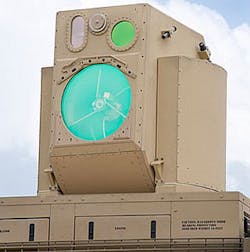Wanted: companies able to design beam controllers for future high-energy laser weapon
HUNTSVILLE, Ala., 12 Aug. 2013. U.S. Army laser weapons experts are surveying industry to find companies able to design a beam controller for a future truck-mounted 50-to-100-kilowatt high-energy laser able to shoot down enemy unmanned aerial vehicles (UAVs), rockets, artillery rounds, and mortars.
Army Space and Missile Defense Command in Huntsville, Ala., on Friday issued a request for information (W9113M-07-C-0177) for a beam-control subsystem (BCS) for the High-Energy Laser Mobile Demonstration (HEL MD) program.
The Boeing Co. Directed Energy Systems segment in St. Louis has been working with the Army on the HEL MD program, which mounts a laser weapon on an eight-wheel heavy military truck to counter UAVs, rockets, artillery, and mortars.
Last October Boeing won a three-year phase-two HEL MD contract to develop and test a 10-kilowatt UAV-killing laser. Tests are scheduled for this year to demonstrate the Boeing laser's ability to acquire, track and destroy a wide range of threat-representative targets. Boeing completed HEL MD low-power testing in June 2011.
Now the Army is looking for companies able to participate in a program to increase the laser weapon's power by five to ten times, and to do this they need companies able to design a reliable beam-control system, which engages the HEL MD's laser weapon on orders from the HEL MD command-and-control system.
The effort will demonstrate a ruggedized BCS not only capable of providing the pointing accuracy necessary for laser weapons to shoot down rockets, artillery rounds, mortars, UAVs, and exposed explosive devices, but also to stand up to the shock and vibration of being mounted to an off-road military truck.
The current beam-control system is composed of several assemblies where software is an essential component of the integrated system, Army researchers explain. The target engagement starts with the BCS in standby mode, which switches to active mode to engage targets.
A target cueing sensor indicates the target location, and then the BCS switches to engagement mode, in which the weapon slews to the target, focuses, and illuminates the target, and determines a precise aim point, and fires the laser.
The HEL MD system uses a modular design approach with an open-system architecture. The HEL MD system can receive several track data files from sensors; acquire target from track data files; track, identify, and rank targets in order of importance; maintain track of acquired targets through obstruction or loss of fine track; determine target aim point and time to engage; direct and maintain the laser beam on the target; and verify target kill.
The HEL MD system includes the laser subsystem (LSS), thermal management system (TMS), beam control subsystem (BCS), command, control, and communications (C3) subsystem, vehicle platform subsystem (VPS), and electrical power subsystem (EPS).
This RFI is for planning purposes only, and is not a solicitation, Army officials point out. Companies interested should respond no later than 3 Sept. 2013. Include company name, points of contact, and relevant expertise.
Email responses to the Army's Neisha Mendiola at neisha.m.mendiola.civ@ mail.mil. Also email Mendiola for questions or concerns.
More information is online at https://www.fbo.gov/spg/USA/SMDC/DASG60/W9113M-07-C-0177/listing.html.

